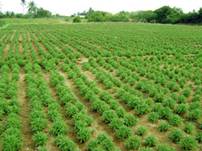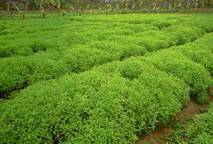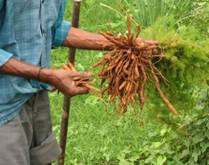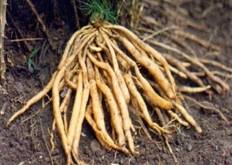
Shatavari is known as the most innocent herb which contains wide range of benefits for human body. It derives its named “Shatavari” as a woman possessing hundred husbands. It is a rejuvenate herb and roots are used about 500tonnes in India every year for the production of medicines. Drugs prepared from Shatavari is used to treat gastric ulcers, dyspepsia and for nervous disorders. It is a shrub with average height of 1-3m with fascicle or clustered roots. Flowers are branched and are 3cm long. Perianth is white with good fragrance and 3mm long. Anthers are purple and berry is purple reddish in color. It is found in Africa, Sri Lanka, China, India and the Himalayas. In India it is found in Arunachal Pradesh,Assam, Chhattisgarh, Delhi, Gujarat, Haryana, Himachal Pradesh, Jharkhand, Kerala and Punjab.
IMPORTANT INFORMATION ABOUT THE PLANTS
| Variety | Asparagus sarmentosa Linn. |
| Common name | Shatavar,shatavari |
| Scientific name | Asparagus racemosus |
| Season Of Planting | June-October |
| Soil | Grows all type of soil except black clay soil |
| Temperature | 5-40 |
| PH | 6-8 |
| Planting through seeds | 12000 plants per acre |
| Spacing( plant to plant) (row to row) | 2’x2’ |
| Seed price | Rs. 8 per plant |
| Irrigation method | Preferably by Drip irrigation/ sprinkler |
| Harvest time | April-May/ After 18-24 Months |
| Total yield | 15 Quintal Dry Roots |
| Buy back rates | Rs 300 Per Kg |
CULTIVATION PRACTICE
Climate– It is grown in warm tropical areas and cannot survive at freezing temperatures. It can be seen growing good in warm and humid climate.
Soil- It is grown in variety of soils such as Red loamy, black soil to laterite soil having good drainage system. It can be also grow in rocky and shallow soil. It gives best result in sandy loam to medium black soil having good drainage system and pH ranging 6-8 ranges best for plant growth.
Planting Time– Transplanting of seedlings should be done in the month of June-July.
Land Preparation– To bring soil to fine tilth, digging of land is to be done at depth of 15 cm. Transplantation is done on raised beds.
Spacing & Plant Population– Normally a spacing of 2‘X2‘ is followed.
Manures & Fertilizers– In general, the crop responds well to the application of organic manure (vermi-compost, neem cake, Trichoderma, Gypsum). About 4-5 tones of organic manure per acre area may be applied at the time of soil preparation and also in the subsequent years. If sufficient quantity of wood ash is available it can be applied in the pits at the time of planting as it helps in establishment of plants & their subsequent growth.
Planting Material– The planting material recommended for commercial cultivation are seeds. Another planting material is root suckers.
Nursery – For 1 acre cultivation, 100 sq feet long nursery is required. Seeds are sown in the month of June-July. The soil is prepared well by digging upto 30-40 cm depth and sow shatavari seeds. After sowing cover beds with thin cloth so it retains moisture. Seedling germination starts after 8-10 days.
Seedlings are ready to transplant after they attain the height of 45 cm.
Irrigation– To get good crops, irrigation at different critical stages of growth is required as follows:
- First Irrigation just after planting of
- Too much irrigation is not required to this crop.
- However, in the starting irrigation is done at the interval of 4-6 days and then after sometimes
Irrigation is done at weekly intervals.
- Irrigation must be done before the harvesting so that digging of roots become easier.
Harvesting-
- The roots of plants get mature by 24 months after plantation.
- Harvesting is done in April – May month.
- Harvesting is done with the help of Kudali.
Post Harvesting-
- After harvesting, peeling is done in boiled conditions.
- After peeling roots are air dried.
- Peeling of roots is required because these Chilka (Upper Layer) have toxins content.
Yield-
- The roots come to maturity in about 20-24 months after planting.
- The average yield is reported to about 1500 kg dry roots after 24 months from one acre.
 Barren land
Barren land Land preparation
Land preparation Planting
Planting  Plant after 10 months
Plant after 10 months Plant after 15 months
Plant after 15 months Plant after 24 months
Plant after 24 months Freshely harvested roots
Freshely harvested roots Roots
Roots Dried roots
Dried roots

